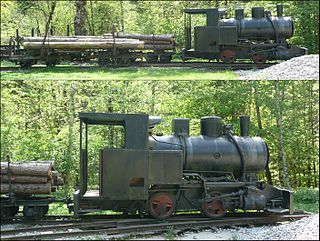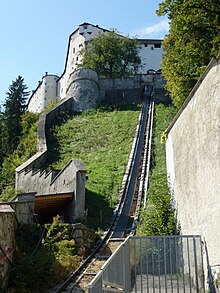
Rail transport is a means of transport that transfers passengers and goods on wheeled vehicles running on rails, which are incorporated in tracks. In contrast to road transport, where the vehicles run on a prepared flat surface, rail vehicles are directionally guided by the tracks on which they run. Tracks usually consist of steel rails.

Wagonways, also known as horse-drawn railways and horse-drawn railroad consisted of the horses, equipment and tracks used for hauling wagons, which preceded steam-powered railways. The terms plateway, tramway, dramway, were used. The advantage of wagonways was that far bigger loads could be transported with the same power.

The history of rail transport began before the beginning of the common era. It can be divided into several discrete periods defined by the principal means of track material and motive power used.

The railway system of Great Britain started with the building of local isolated wooden wagonways starting in the 1560s. A patchwork of local rail links operated by small private railway companies developed in the late 18th century. These isolated links expanded during the railway boom of the 1840s into a national network, although still run by dozens of competing companies. Over the course of the 19th and early 20th centuries, these amalgamated or were bought by competitors until only a handful of larger companies remained. The entire network was brought under government control during the First World War and a number of advantages of amalgamation and planning were demonstrated. However, the government resisted calls for the nationalisation of the network. In 1923, almost all the remaining companies were grouped into the "Big Four": the Great Western Railway, the London and North Eastern Railway, the London, Midland and Scottish Railway and the Southern Railway. The "Big Four" were joint-stock public companies and they continued to run the railway system until 31 December 1947.
The year 1604 in science and technology involved some significant events.

The railway track or permanent way is the elements of railway lines: generally the pairs of rails typically laid on the sleepers or ties embedded in ballast, intended to carry the ordinary trains of a railway. It is described as permanent way because in the earlier days of railway construction, contractors often laid a temporary track to transport spoil and materials about the site; when this work was substantially completed, the temporary track was taken up and the permanent way installed.

The Tanfield Railway is a 4 ft 8+1⁄2 instandard gauge heritage railway in Gateshead and County Durham, England. Running on part of a former horse-drawn colliery wooden waggonway, later rope & horse, lastly rope & loco railway. It operates preserved industrial steam locomotives. The railway operates a passenger service every Sunday, plus other days, as well as occasional demonstration coal, goods and mixed trains. The line runs 3 miles (4.8 km) between a southern terminus at East Tanfield, Durham, to a northern terminus at Sunniside, Gateshead. Another station, Andrews House, is situated near the Marley Hill engine shed. A halt also serves the historic site of the Causey Arch. The railway claims it is "the world's oldest railway" because it runs on a section dating from 1725, other parts being in use since 1621.

A plateway is an early kind of railway, tramway or wagonway, where the rails are made from cast iron. They were mainly used for about 50 years up to 1830, though some continued later.

Strelley is a village and civil parish in the Borough of Broxtowe and City of Nottingham in Nottinghamshire, England. It is to the west of Nottingham. The population of the civil parish taken at the 2011 census was 653. It is also the name of the nearby post war council housing estate. The village lies within the Broxtowe district, whilst the estate is in the City of Nottingham. The village is separated from the housing estate by the A6002 road.

Tramways are lightly laid industrial railways, often not intended to be permanent. Originally, rolling stock could be pushed by humans, pulled by animals, cable-hauled by a stationary engine, or pulled by small, light locomotives. Tramways can exist in many forms; sometimes simply tracks temporarily placed on the ground to transport materials around a factory, mine or quarry. Many use narrow-gauge railway technology, but because tramway infrastructure is not intended to support the weight of vehicles used on railways of wider track gauge, the infrastructure can be built using less substantial materials, enabling considerable cost savings.
Huntingdon Beaumont (c.1560–1624) was an English coal mining entrepreneur who built two of the earliest wagonways in England for trans-shipment of coal. He was less successful as a businessman and died having been imprisoned for debt.

The Wollaton Wagonway, built between October 1603 and 1604 in the East Midlands of England by Huntingdon Beaumont in partnership with Sir Percival Willoughby, has sometimes been credited as the world's first overground wagonway and therefore regarded as a significant step in the development of railways. Its primacy has been recently questioned because of a wagonway built at Prescot, near Liverpool, sometime around 1600 and possibly as early as 1594. Owned by Philip Layton, this line carried coal from a pit near Prescot Hall to a terminus about half a mile away. Also, a wagonway at Broseley in Shropshire was probably earlier.
The history of rail transport in Great Britain to 1830 covers the period up to the opening of the Liverpool and Manchester Railway, the world's first intercity passenger railway operated solely by steam locomotives. The earliest form of railways, horse-drawn wagonways, originated in Germany in the 16th century. Soon wagonways were also built in Britain. However, the first use of steam locomotives was in Britain. The invention of wrought iron rails, together with Richard Trevithick's pioneering steam locomotive meant that Britain had the first modern railways in the world.
The Polloc and Govan Railway was an early mineral railway near Glasgow in Scotland, constructed to bring coal and iron from William Dixon's collieries and ironworks to the River Clyde for onward transportation.

The Tranent to Cockenzie Waggonway was an early waggonway, possibly the first in Scotland, opened in 1722. It was 2+1⁄2 miles (4 km) miles long and connected coal pits at Tranent with the salt pans at Cockenzie and harbour at Port Seton in East Lothian, Scotland. The track was wooden, and wagons were drawn by horses. The Battle of Prestonpans in 1745 was fought across the line.
The Brampton Railway was a mineral railway built in 1798 to bring coal from workings on Tindale Fell to staiths at Brampton. It was a development of short sections of earlier wooden railways.

A mine railway, sometimes pit railway, is a railway constructed to carry materials and workers in and out of a mine. Materials transported typically include ore, coal and overburden. It is little remembered, but the mix of heavy and bulky materials which had to be hauled into and out of mines gave rise to the first several generations of railways, at first made of wooden rails, but eventually adding protective iron, steam locomotion by fixed engines and the earliest commercial steam locomotives, all in and around the works around mines.
This article lists events relating to rail transport that occurred during the 1720s.
The Silkstone Waggonway was a narrow-gauge industrial wagonway serving the Barnsley Canal, in England, at Silkstone in South Yorkshire.












